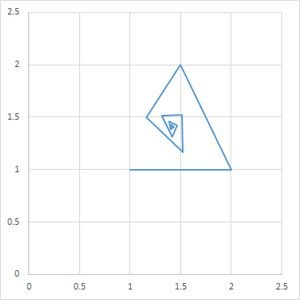Wait...this converges?
A function f ( n ) is defined recursively as:
-
f 0 = 1 ,
-
f 1 = 1 , and
-
f n = f n − 1 ∗ f n − 2 f n − 1 + f n − 2 .
This function converges to a specific number x which can be expressed as a ∗ b + c , where a, b, and c are all whole numbers.
Find a + b + c . If you think this function does not converge, type − 1 .
The answer is 3.
This section requires Javascript.
You are seeing this because something didn't load right. We suggest you, (a) try
refreshing the page, (b) enabling javascript if it is disabled on your browser and,
finally, (c)
loading the
non-javascript version of this page
. We're sorry about the hassle.
2 solutions
If indeed this function converges, at some point it must recursively define itself - i.e. f n = f n ∗ f n f n + f n (but of course at infinity). Letting f n = x , we solve the equation x = x ∗ x x + x , or x = x 2 2 x . Multiplying both ides by x 2 we arrive at x 3 = 2 x , which transposes and factors as ( x ) ( x 2 − 2 ) = 0 . So our possible solutions are x = 0 , ± 2 . However, by definition, all our terms are positive since the product of two positive terms can never be negative or zero. Thus, we discard the x = 0 and x = − 2 solutions. So our final answer is x = 2 , and in the required form it is x = 1 ∗ 2 + 0 . So a + b + c = 1 + 2 + 0 = 3 .
You should prove its convergence.
Log in to reply
If the series were to diverge, the sequence terms would have to exceed 2. But for any n>2, multiplication always 'grows' faster than addition, and would therefore lead to the denominator being larger, hence a fraction less than 1. This is a contradiction, so the series must converge.
Log in to reply
You proved that the sequence is bounded. It doesn't mean it is converging. For example it might happen that (only an example) f 2 k → 7 1 ; f 2 k + 1 → 1 1 5 as k → ∞ .
Log in to reply
@Veselin Dimov – This is a pretty interesting sequence - the convergence seems quite chaotic. The terms don't switch between being greater or less than 2 with any obvious pattern. They also don't get closer each term; for example ∣ ∣ ∣ f n + 1 − 2 ∣ ∣ ∣ > ∣ ∣ ∣ f n − 2 ∣ ∣ ∣ for n = 4 , 9 , 1 2 , 1 4 ⋯ .
This sort of behaviour makes me think a trig substitution could work, but I haven't found one that does yet.
@Veselin Dimov – Yup - you're right.
Log in to reply
@Daniel Xian – But that raises a question - is proving a sequence is bounded, then finding a singular point somewhere in that bound that recursively defines itself, sufficient to prove that the series converges?
Log in to reply
@Daniel Xian – Not quite. How about the sequence x 0 = 2 1 , x n + 1 = f ( x n ) = 2 1 x n ( 1 − x n ) + 3
You can check that
1) it's bounded above and below
2) there's just one point within those bounds such that f ( x ) = x
3) it doesn't converge
(there may be simpler counterexamples - it's quite interesting to try and find them)
Say x n = f n , y n = f n − 1 for n ≥ 1 . Also define F ( x , y ) = ( x 1 + y 1 , x ) so that ( x n + 1 , y n + 1 ) = F ( x n , y n )
We can now use some stability theory . The fixed points of the map F are at x = y = ± 2 .
The Jacobian of F is J ( x , y ) = ( x 2 − 1 1 y 2 − 1 0 )
Evaluating this at either fixed point we get J ( ± 2 , ± 2 ) = ( 2 − 1 1 2 − 1 0 )
whose determinant is 2 1 . Since this is less than one in absolute value, the fixed points are both stable.
Now since both f 0 and f 1 are positive, all f n are; so the sequence can only converge to 2 .
Here's a plot of the above map: